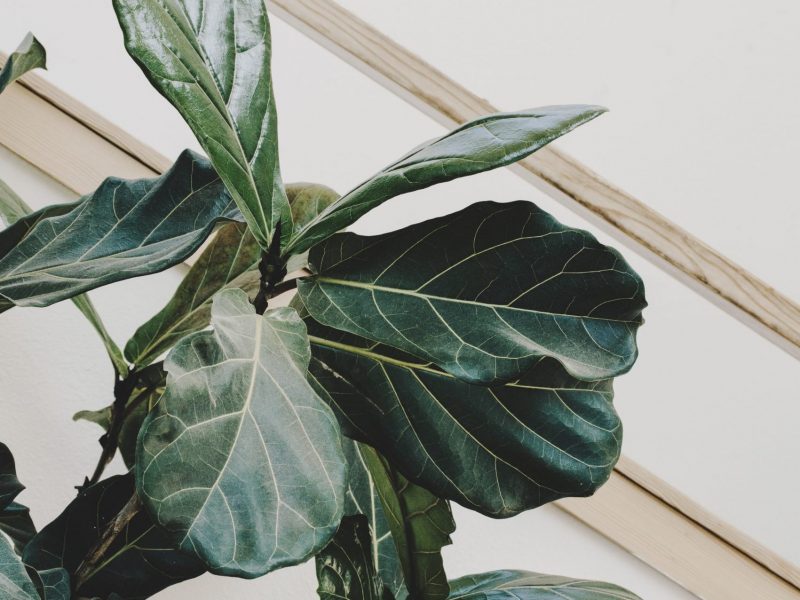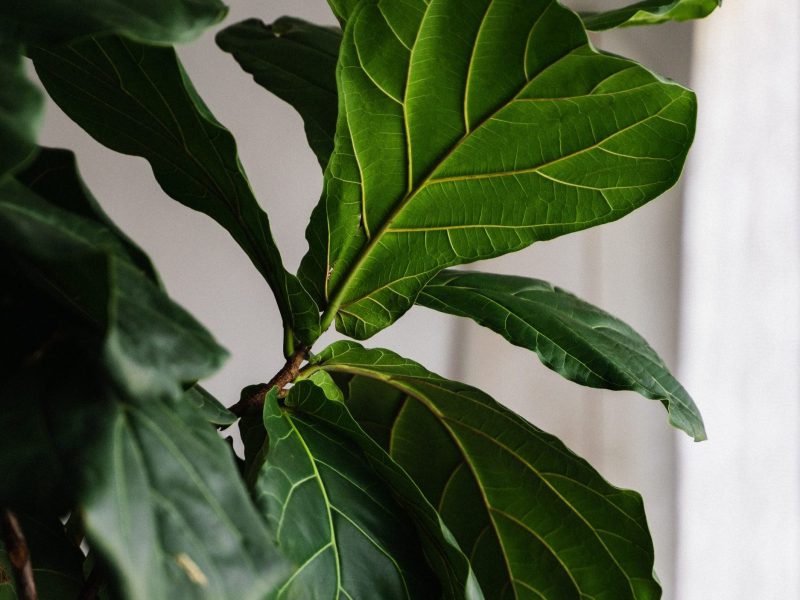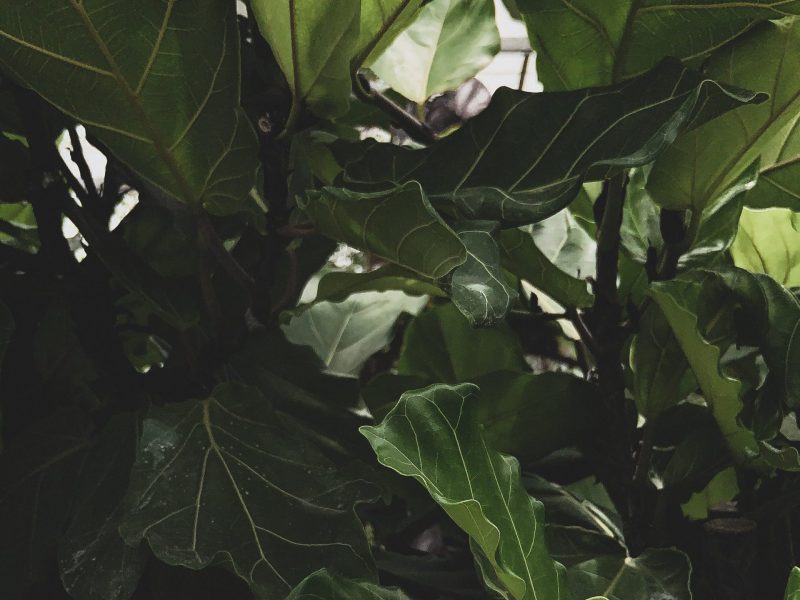Fiddle Leaf Fig Tree
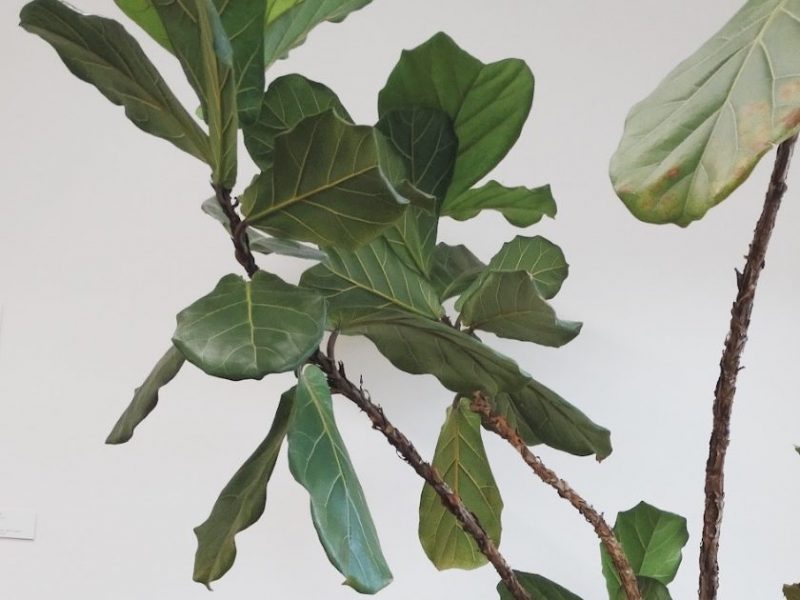
Introduction to the Fiddle Leaf Fig Tree
The Fiddle Leaf Fig Tree, known scientifically as Ficus Lyrata, is best known for its striking, broad leaves and tall stature making it a favorite among plant enthusiasts and interior designers alike. While it’s not the fussiest plant out there, it still has its specific environmental and care requirements which we will go through in this guide.
Originally from the tropical rainforests of Western Africa, the Fiddle Leaf Fig Tree is accustomed to a warm, humid environment. The “fiddle” in its name comes from the shape of its leaves, which resemble a fiddle or violin.
Characteristics of the Fiddle Leaf Fig Tree
Physical Features
The Fiddle Leaf Fig tree is a tall, columnar plant that can grow up to 2.5 meters (8 feet) in height indoors. In its natural habitat, it can reach up to 15 meters (50 feet). The plant’s signature characteristic is its large, glossy, fiddle-shaped leaves with prominent veins that grow on woody stems. The leaves can be as long as 45 cm (18 inches) and are a rich, deep green color.
Growth Pattern
Fiddle Leaf Fig trees grow in a pattern that’s unique to each individual plant, depending on the light and space available. In general, they grow slowly, adding 1-2 leaves per month during the growing season. They can grow quite tall indoors if not pruned regularly.
Life Span
With proper care, a Fiddle Leaf Fig Tree can live for several decades. It’s not uncommon for these plants to be passed down from generation to generation.
Indoor Adaptability
Despite its preference for a tropical environment, the Fiddle Leaf Fig Tree adapts well to indoor conditions. They can withstand some lower light levels and dry air, common in most indoor settings. However, they do have their limits and won’t thrive in extremely low light or cold, drafty areas.
Large Fiddle Leaf Fig

Fiddle Leaf Fig Tree Lighting Needs
Your Fiddle Leaf Fig Tree thrives best in bright, indirect sunlight. This tropical plant, native to the rainforests of West Africa, is accustomed to receiving a lot of light filtered through the forest canopy. However, it’s important to remember that while they enjoy a good amount of light, they shouldn’t be exposed to direct sunlight as it can burn their leaves.
Consider the following tips to ensure your Fiddle Leaf Fig Tree gets the appropriate amount of light:
- Indirect Light: Position your plant near a window that receives plenty of natural light. An east-facing window is ideal. However, be sure to diffuse the light if it gets too intense, especially during the peak hours of the day.
- Rotation: Rotate your tree every few weeks to ensure all sides receive equal exposure to light. This helps to promote even growth and prevents the tree from leaning towards one side.
- Artificial Light: During darker winter months, or if you live in a low-light environment, you might need to supplement with a grow light. This provides the light spectrum necessary for the plant to photosynthesize.
A lack of adequate light can lead to a number of problems such as drooping leaves, leaf loss or stunted growth so it’s not just too much sunlight that can be the issue.
Monitoring your Fiddle Leaf Fig’s reaction to the light it receives is crucial. If you notice the leaves turning brown or the plant becoming leggy, it might be due to inadequate light. Try moving your plant to a brighter location or adjusting the light conditions as necessary.
Watering your Fiddle Leaf Fig Tree
When it comes to the frequency of watering, a rule of thumb is to keep a consistent schedule. This can vary based on the size of the tree, the pot size, and the environment. However, on average, watering once a week should be sufficient.
Here are some general guidelines to follow while watering your Fiddle Leaf Fig Tree:
- Ensure the soil dries out between waterings: Before watering, make sure the top inch of the soil is dry. Fiddle Leaf Fig Trees prefer their soil to dry out a bit between waterings as overwatering can lead to root rot and other problems.
- Use room-temperature water: Cold or hot water can shock or burn the plant’s root system. It’s best to use water that is at room temperature to avoid any potential stress to the plant.
- Water deeply: When you water, do so deeply, ensuring that the water reaches the root ball. This encourages the roots to grow deeper, promoting a healthier plant.
The goal is to mimic the plant’s natural tropical environment. In its natural habitat, a Fiddle Leaf Fig Tree would experience heavy rainfall followed by periods of dryness. Therefore, the watering cycle should reflect this.
Temperature and Humidity Requirements
Your Ficus lyrata is a tropical plant by nature which means it thrives in warmer temperatures and higher humidity conditions that mimic its native environment.
Temperature: Fiddle Leaf Fig Trees prefer a warmer climate. The ideal temperature range is between 65 and 75 degrees Fahrenheit during the day. At night, temperatures can drop slightly but should remain above 50 degrees Fahrenheit. Extreme fluctuations in temperature can cause stress to your Fiddle Leaf Fig, so try to maintain a consistent environment and monitor the temp for any changes.
Humidity: High humidity levels are beneficial for your Fiddle Leaf Fig and it’s accustomed to humidity levels around 50% to 65%. If you live in a dry environment, you might need to create additional humidity for your plant (see our tips below to achieve this).
Creating the Ideal Environment
Creating the right temperature and humidity levels for your Fiddle Leaf Fig Tree is just as important as how much water you give it as the wrong levels of either can cause serious irreversible issues. Here are some tips:
- Position – Keep your plant away from drafts, heat vents, and air-conditioning units. These can cause sudden temperature fluctuations.
- Pebble trays – If you’re in a dry environment, consider using a humidity tray. Fill a shallow tray with small stones or pebbles, add water, and place your plant pot on top. As the water evaporates, it increases the humidity around the plant.
- Misting – Another option for increasing humidity is to mist your Fiddle Leaf Fig Tree. Spray a fine mist of water onto the leaves every few days. However, be careful not to overdo it, as too much moisture can lead to mold growth.
Fertilizating your Fiddle Leaf Fig Tree
What kind of Fertilizer do you need?
Use a balanced, water-soluble fertilizer. Look for something that has equal parts Nitrogen (N), Phosphorus (P), and Potassium (K). This would typically be marked as 10-10-10 or 20-20-20 on the fertilizer bottle.
How often should you fertilize?
Fertilizing frequency depends on the time of year. In spring and summer fertilize your Fiddle Leaf Fig Tree once a month but cut back completely during fall and winter as your plant will largely be in a dormant phase.
Fertilizing Steps
- Water your Fiddle Leaf Fig Tree thoroughly. This helps to prevent the roots from burning due to the concentrated nutrients in the fertilizer.
- Prepare the fertilizer according to the package instructions. We do tend to recommend diluting it slightly more than recommended to avoid any potential overfertilization.
- Apply the fertilizer to the soil, avoiding direct contact with the leaves.
- Wait for the plant to absorb the fertilizer before watering again.
Remember, over-fertilizing can cause more harm than good. If the leaves of your Fiddle Leaf Fig Tree start to yellow or fall off, you might be using too much fertilizer. When in doubt, it’s better to under-fertilize than overdo it.
Fiddle Leaf Fig ready for repotting!
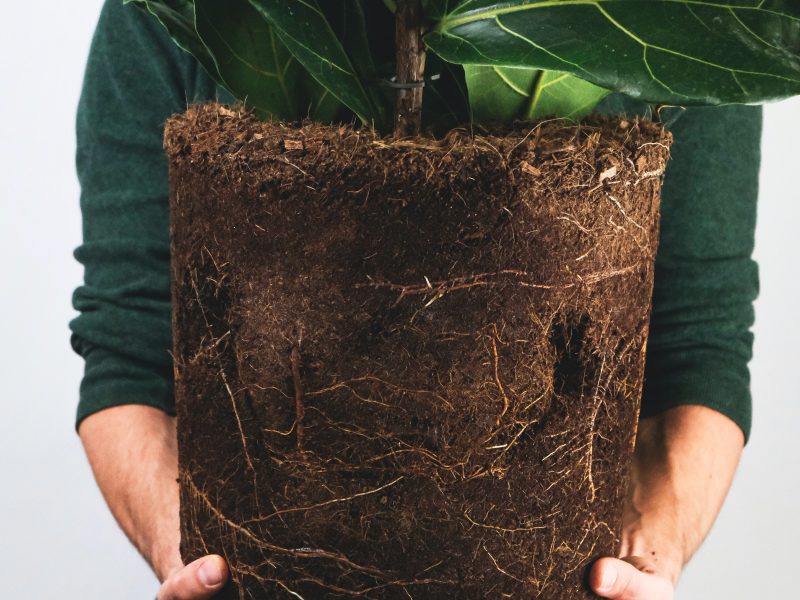
Repotting a Fiddle Leaf Fig Tree
Repotting your Fiddle Leaf Fig Tree is an essential part of its care routine but it often intimidates many plant owners. Although it can be a little tricker than repotting some other plants because of the size that these trees can grow to, the main elements are exactly the same.
When to Repot
The best time to repot your Fiddle Leaf Fig is during the spring or early summer when the tree is in its growth phase as this will help your plant get over the shock of repotting. Look for signs that your tree needs repotting, such as roots growing out of the drainage holes or the plant becoming top-heavy.
Choosing the Right Pot
When repotting, you should always choose a pot that’s only slightly larger than the current one. Going up by 2 to 4 inches in diameter is usually a good rule of thumb. This will give the plant enough space to grow, but not so much that the roots will be unstable. If the pot is too big it also means there is a lot more soil in there which can retain a lot more moisture than before, contributing to a higher risk of root rot.
Steps to Repot a Fiddle Leaf Fig Tree
- Prepare the new pot: Before you begin, make sure your new pot has adequate drainage. Add a layer of well-draining soil to the bottom of the pot.
- Remove the tree from the current pot: Carefully remove the tree from its current pot. If the tree is stuck, you can gently tilt the pot and tap it to loosen the root ball. The best way of doing this is to carefully lay the tree down, so you aren’t lifting it up as this can hurt your back.
- Prune the roots: Look for any dead or damaged roots and prune them. Don’t be afraid to prune a good portion of the roots. This will make room for new growth.
- Place the tree in the new pot: Position your tree in the center of the new pot and add soil around it. Be sure to firm the soil around the base of the tree to ensure it’s stable.
- Water thoroughly: After repotting, water your tree thoroughly. This will help settle the soil and remove any air pockets.
Pruning your Fiddle Leaf Fig Tree
Why Prune Your Fiddle Leaf Fig Tree?
- Health: Regularly removing dead or dying leaves helps prevent the spread of disease and pests.
- Appearance: Pruning helps maintain the tree’s shape and size, enhancing its overall look.
- Growth: Pruning encourages the tree to grow more branches and leaves, resulting in a fuller appearance.
When to Prune Your Fiddle Leaf Fig Tree
The ideal time to prune your Fiddle Leaf Fig Tree is during the growing season, typically in the warmer months. However, if you notice diseased or dead leaves, it’s best to remove them immediately, regardless of the season.
How to Prune Your Fiddle Leaf Fig Tree
Follow these simple steps for effective pruning:
- Prepare Your Tools: Ensure your pruning shears are sharp and disinfected to prevent damage and disease.
- Identify What to Prune: Look for yellow, brown, or wilted leaves. Also, consider removing any overcrowded branches to allow better light penetration.
- Make the Cut: Cut at an angle, leaving about a quarter-inch of the stem attached to the tree. Be careful not to damage the main stem or branch.
Cleaning the Leaves
Why is Cleaning Necessary?
Over time, dust and grime can accumulate on the leaves, limiting their ability to photosynthesize effectively. This is because dust particles obstruct sunlight, which is crucial for photosynthesis. In addition, removing dust and grime also helps in preventing pests and diseases.
Leaf Cleaning Process
Here is a simple guide on how to clean the leaves of your Fiddle Leaf Fig Tree:
- Prepare a Cleaning Solution: You can make a gentle cleaning solution by mixing a few drops of mild liquid soap in a bowl of lukewarm water. However, do not use any harsh chemicals as it can damage the top layer of the leaves.
- Use a Soft Cloth: Dip a soft cloth or sponge into the cleaning solution. Wring it out to remove excess water.
- Clean the Leaves: Gently wipe each leaf starting from the base and moving towards the tip. Be careful not to apply too much pressure as this can damage the leaves. It’s a good idea to use your other hand to support the leaf from behind.
- Let Them Dry: After cleaning, let the leaves air dry. Avoid direct sunlight during this process to prevent leaf burn.
Fiddle Leaf Fig Tree Toxicity
Humans:
For humans, the Fiddle Leaf Fig Tree’s sap can result in a rash if it comes into contact with the skin. Further exposure can lead to more severe reactions, like eye irritation or even temporary blindness. If consumed, it can cause a burning sensation in the mouth, throat, and digestive tract. Therefore, it’s advised to handle this plant with care and keep it out of reach from children.
Pets:
The Fiddle Leaf Fig Tree is toxic to pets as the sap can irritate the skin, eyes and mouth of your pets. If ingested, the plant can cause vomiting, diarrhea, and even more serious health issues.
If you or your pet come into contact with the sap, immediately wash the affected area with soap and water. If symptoms persist, seek medical or veterinary assistance promptly.
Note: This information is intended for general guidance and does not replace professional medical or veterinary advice.
Fiddle in the Living Room
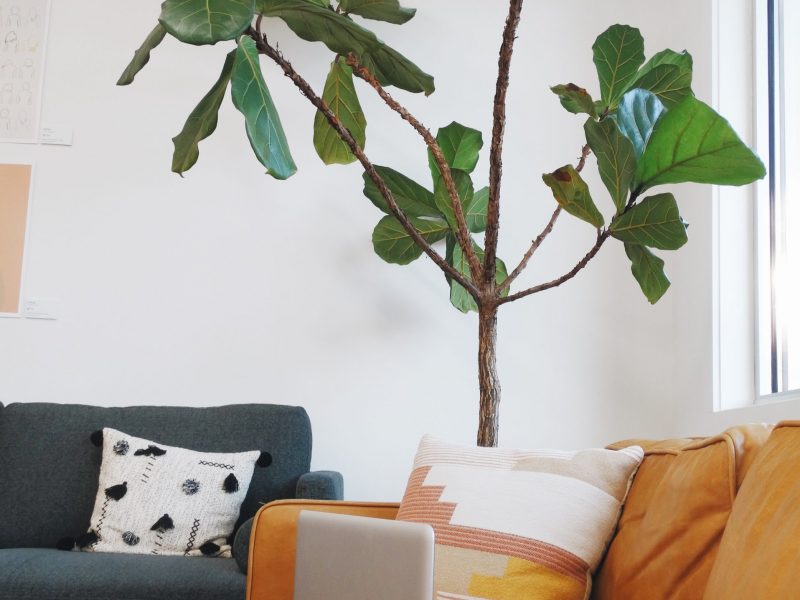
Pest and Disease Management
Common Pests
The most common pests that you might encounter with your Fiddle Leaf Fig are mealybugs, spider mites, and aphids. These pests can cause yellowing of the leaves, leaf drop, and overall decline in the health of your plant.
- Mealybugs: These appear as small, white cottony masses on the leaves and stems. They suck plant sap, leading to yellowing and wilting.
- Spider Mites: These are tiny, spider-like creatures that are typically red or black. They also suck sap, causing yellow or brown spots on the leaves.
- Aphids: Small, green or black insects that can cause curling and yellowing of the leaves.
Common Diseases
Fiddle Leaf Figs can also be affected by a few diseases, most commonly root rot and leaf spot.
- Root rot: This is usually caused by overwatering. Look for brown, mushy roots and a foul smell. If left untreated, the plant will wilt and eventually die.
- Leaf spot: This appears as brown or black spots on the leaves. It can be caused by a fungal or bacterial infection, often due to high humidity and poor air circulation.
Managing Pests and Diseases
Effective pest management involves regular checking and trying to spot the issue as early as possible. This will give you the best chance at successfully treating the issue.
- Inspect regularly: Check your plant’s leaves, stems, and soil regularly for any signs of pests or diseases.
- Use appropriate treatment: For pests, use a mild insecticide or a homemade solution of soapy water. For diseases, you might need to use a commercial treatment or remove affected parts of the plant.
- Maintain a healthy environment: Keep your plant in good health through proper watering, lighting, and temperature. A healthy plant is less susceptible to pests and diseases so preventing the issue is of course the best way to avoid having to treat it in the first place.
Fiddle Leaf Fig FAQs
How often should I water my Fiddle Leaf Fig?
You want to make sure that your Fiddle Leaf Fig has time to dry out a little between waterings as this will help to prevent root rot. During the hottest months, you’ll want to water your Fiddle once a week to aid with growth but cut back during winter when your plant will need less and the soil takes longer to dry out.
Are Fiddle Leaf Fig Trees toxic?
Yes, Fiddle Leaf Fig Trees are toxic when ingested so you want to keep them away from pets or children who might chew on the leaves.
How tall do Fiddle Leaf Fig Trees get?
When potted and grown indoors, the Fiddle Leaf Fig Tree can reach up to about 9 or 10 feet if in the right environment and given the right care. In their native natural environment, they can grow much taller, to about 40-50 feet.
Are Fiddle Leaf Fig Trees easy to care for?
Fiddle Leaf Fig Trees aren’t the easiest houseplant to care for because they can be a little fussy about their care and environment. However, once you’ve found a good spot and worked out a care routine, they can become quite low maintenance.
Can Fiddle Leaf Fig Trees survive in low light?
Unfortunately, Fiddle Leaf Figs don’t thrive in low light areas as they can quite quickly begin to drop their leaves. You want to find a spot that has bright but indirect light.
Common Problems with your Fiddle Leaf Fig
Why are my Fiddle Leaf Fig's leaves drooping?
Drooping leaves on your Fiddle Leaf Fig Tree is most probably due to watering issues, too much, too little, not enough drainage. There is quite a lot of information on this which is why we have written a whole guide on why your Fiddle Leaf Fig’s leaves are drooping.
Why are my Fiddle Leaf Fig's leaves turning yellow/brown?
Yellow leaves on your Fiddle Leaf Fig Tree may be a sign of watering issues or light sensitivity. We have written a detailed guide to help you diagnose why your Fiddle Leaf Fig has yellow leaves.
Why is my Fiddle dropping leaves?
If you see that your Fiddle Leaf Fig is losing leaves, it may be due to underwatering, dry air or a sudden change in environment amongst other things. We have written an extensive guide to help you diagnose why your Fiddle Leaf Fig Tree is losing leaves.
Dark brown edges on your Fiddle Leaf Fig's leaves
Brown edges on your Fiddle Leaf Fig could be a sign of overwatering so check the moisture in the soil. Make sure to water it a little less or replace with fresh soil if it is waterlogged. For more information, see our guide on brown Fiddle Leaf Fig leaves.
Why are there brown spots on my Fiddle Leaf Fig's leaves?
If you see brown spots on your Fiddle Leaf Fig it could be getting too much sun or the temperature is too low so see if there is another spot in your home more suited to its needs.
Small pests on the underside of my Fiddle Leaf Fig's leaves
Fiddle Leaf Fig Trees can suffer from a range of pests. Wipe them off with a warm and soapy cloth or treat with insecticide if the problem persists. We have written a guide on how to get rid of the common pest Spider Mites.
My Fiddle Leaf Fig Tree has been neglected
We totally understand that sometimes it isn’t possible to give your houseplants all the love they require. This is why we have written a specific guide on how to revive your dying Fiddle Leaf Fig Tree.



